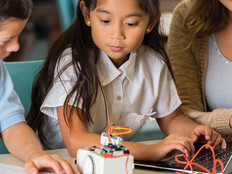One School District Is Building Its Classrooms with Tech in Mind
Third-grade teacher Michelle Lingenfelter stands in front of what looks like the ultimate wall unit in her classroom at South Carolina's Charleston Progressive Academy. At its center is a floor-to-ceiling cabinet with an interactive whiteboard mounted to it. On each side of the cabinet are open shelves stocked with a computer, document camera, tablet-charging station and other equipment. Whiteboards slide across the open shelves and lock, providing secure storage space when the equipment isn't in use.
"Let's review last night's homework," Lingenfelter tells the room full of children, who break into groups. Some sit in the clusters of four desks that connect to form tables. Two boys lie on the carpet. Others move to the beanbag chairs beneath the wall of windows.
"It's about making people comfortable, just like we want to be in our workspaces," says Tim Tanner, technology integration specialist for the Charleston County School District. "Research has found that it breeds creativity."
Lingenfelter — who wears a lanyard with a microphone that's connected to the sound system installed in the ceiling — isn't fazed as the volume in the room rises. "They're allowed to talk," she explains, noting that the setup allows students to hear her from anywhere in the room.
Rather than redesign aging classrooms, Charleston Progressive Academy got the chance to start from scratch, thanks to a six-year, 1-cent sales tax to fund capital improvements throughout the district. CPA is one of 13 schools that CCSD is rebuilding with the funding. The tax also will pay for five brand-new schools.
Since CPA was in the first of five construction phases, it serves as a model for those schools still waiting to break ground. The school of 370 K–6 students has large, open rooms filled with daylight and an array of chairs, tables and desks. A computer lab has tables with openings for notebook computers that can fold down for a flat desk surface.
Lingenfelter's wall unit, called the teaching wall, was custom designed for CCSD schools to meet the district's first design objective — to create organized spaces, explains Lainie Berry, CCSD's educational technology director. Each unit stores supplies, keeps cords out of view and offers a centralized place for equipment.
The second objective — to center rooms around mobile technology — stemmed from the fact that CCSD schools are moving toward a one-to-one tablet program. As the district rebuilds schools or refreshes furniture, it's replacing rows of desks with assorted furniture in nooks and crannies throughout each room, so that students "don't have to be tied to their desks," Berry says.
The third objective relates to the idea that physical activity leads to better retention and learning. To that end, CCSD is adding furniture that supports movement during class. It can be as simple as a swivel stool or as sophisticated as desks built onto stationary bicycles. "We're trying to get the message out that as more technology comes in, kids should be moving more," Berry adds.
CCSD leaders have left room for teachers and students to customize their spaces. "You want it to be an evolving process," Berry says, "keeping that student — the learner — at the center of it."
Here’s a look at Charleston Progressive Academy, a downtown elementary school that serves as a model for many of the district’s upcoming renovation projects.






